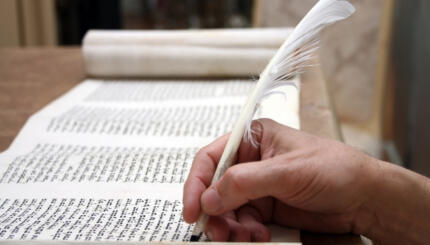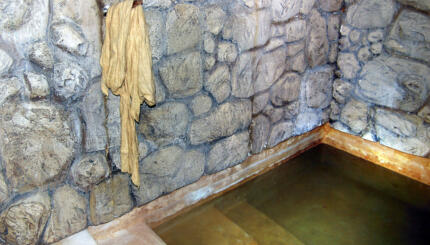Reprinted with permission from Iyyun, an institute for the exploration of the deeper dimensions of Torah.
In a self-contained and rigid paradigm of cause and affect, action/reaction, freedom is merely an illusion, a deception of what truly is. Yet, as we sit down to the Seder on Passover night, we aspire and dream of freedom, genuine freedom–what existentialists would call “radical freedom”–where we choose “just because: uninfluenced and non-reactive. But is this freedom truly attainable? Is not every choice determined by a previous choice?
In a created evolving universe, once something is set into motion, the ripple effects are interminable. Every effect can be traced to a cause, and the cause in turn is merely an effect of a previous cause. Such is the nature of a closed system, what is referred to in Kabbalistic language as “
histalshelut–evolving order.” On Passover night, however, we are given the power to tap into a space beyond “seder hishtalshelut,” beyond the “order of universe” transcendent of cause/effect and access genuine freedom. Doing so affords us the ability to articulate our beyond seder (order) freedom throughout the entire seder of the coming year.
Speaking of Freedom
Before leapfrogging to beyond order we need to secure the vessels of order, as only “a filled vessel is able to receive.” Before we begin reciting the haggadah, which speaks of freedom, we ensure that we are prepared for the experience, so that later on we are able to integrate the experience of ‘beyond order’ in real time, within the workings of ‘order’ and the natural flow of life.
Let’s begin by understanding the process of seder histalshelut on a cosmic level.

Help us keep Jewish knowledge accessible to millions of people around the world.
Your donation to My Jewish Learning fuels endless journeys of Jewish discovery. With your help, My Jewish Learning can continue to provide nonstop opportunities for learning, connection and growth.
Initially there was and is only “or ein sof–the endless light,” absolute oneness and unity. Thus, finite creative reality as we know it, and as we understand it to be, couldn’t have merged. To create otherness and apparent separation there was a great tzimtzum–contraction and concealment of the ein sof within itself–and finite came into focus. The first otherness that took shape was “formed” as an igul–circle. The image is of a circular space in which all potential reality was contained within as one, non-individuated, and non-distinct, no beginning and no end. Within the circle a line, a kav, was formed with distinct points and an up-and-down sequential structure with a clear beginning and a definite end.
These original points are the ten sefirot, and it is through these ten screens of sefirot that the infinite light of the ein sof penetrates our reality. The distinct ‘formed,’ ‘shaped’ and ‘colored’ sefirot serve as curtains or colored containers through which the infinite colorless, formless, unified light is reflected into our world, albeit in a way that it seems differentiated and colored.
Sefirot Order
The order of the sefirot are as follows:
First there are the three intellectual sefirot; chochmah (intuition and wisdom), binah (cognition and reason), and da’at (knowledge and awareness).
Next are the three primary ‘internal emotions’; on the right expansive column is hesed (love and giving). On the left restrictive column is gevurah (strength and restraint). In the middle is their synthesis, tiferet (compassion and harmony). –The idea of the ‘giver’ giving with a sensitivity of how much the ‘receiver’ could and needs to receive.
The ‘outer’ emotions are also divided into three: on the right expansive column is netzah (confidence and perseverance). On the left column is hod (humility and devotion), and in the middle is the unifying agent, connecting the ‘giver’ and the ‘receiver,’ the idea of yesod (relationship and intimacy).
Malchut (kingship) is receptiveness, as it represents the vessel that receives from the preceding nine sefirot and re-channels the energies downward, thus becoming the ‘crown’ for the subsequent partzuf (structure of sefirot).
Mimicking the cosmic unfolding of seder histalshelut, we first take hold of an igul (circle), as in a round seder plate, and begin by placing three matzot one on top of the next. The three matzot represent the three intellectual sefirot: chochmah, binah and da’at, as the consumption of wheat is connected with our intellectual and discerning development. In the words of the Talmud, “a child does not know how to call ‘father’ and ‘mother’ until it has had a taste of wheat.”
Next we arrange six items of food in two upside-down triangles, the triangles reflecting internal and outer emotions respectively. Collectively these six items represent six points of light, the six emotional sefirot.
Shankbones, Eggs, and Vegetables
On the upper right side of the plate the zeroah (shank bone) is arranged. The Hebrew word zeroah reminds us of the zeroah netuya (the outstretched arm), the divine hesed (loving kindness) that was shown to us, that brought us our salvation. On the opposite side, on the upper left column we place the beitza (egg). The egg is a traditional food of mourning, as the oval shape represents the circle of life with its ups and downs.
The egg is associated with (gevurah) restraint and restriction, a time of loss, when there is a concealment of apparent kindness. In the middle, at the third point of the triangle, (maror) bitter herbs are arranged reflecting the attribute of tiferet (mercy and compassion). Becoming aware of our own spiritual condition may arouse a bitterness within and provoke divine compassion. Besides, when we, through external stimuli feel pain we awaken our own ability to be empathetic to others who are truly in pain.
Next we arrange the lower triangle, reflecting the outer emotional sefirot. On the lower right column we place the haroset, which is a mixture of various fruits that are crushed into a liquid like form. The haroset corresponds to the sefira of netzah, as the haroset is comprised of fruits of trees, growing tall and mighty, mirroring the energy of confidence and perseverance. Across, on the lower left column we arrange the karpas, a vegetable, either an onion or potato.
The karpas reflects the idea of hod (humility), as vegetables, in contrast to fruit, grow within or in close proximity to the earth. In fact, in the word karpas one can find the words caf (palm) and ras (poor), the hand of the poor open to receive in its humility. In the lower middle column the hazeret is placed. The hazeret is the bitter herbs that will be eventually used in the Hillel sandwich. Hazeret reflects the sefira of yesod, the connecting force, that which binds together, as the hazeret is sensitive and will unify the entire internal structure of the seder, bringing together freedom and exile, affliction and salvation, unifying the matzah–the bread of liberation–with the maror, which represents our suffering and pain.
All the above is placed on the actual plate, which is malchut, the vessel and container of all the points of light.
Having arranged the items in their appropriate locations, securing that ‘order’ is in place, we can now be on our journey towards radical infinite freedom, attaining this awesome power by revealing the infinity which is beyond histalshelus, beyond ‘worlds’, beyond the worlds of actualization, formation or creation, and allowing for the manifestation of, in the words of the Haggadah, “ I, and not an angel…I, and not a seraph…I, and not a messenger, but I Hashem.”


